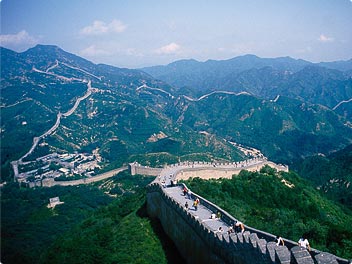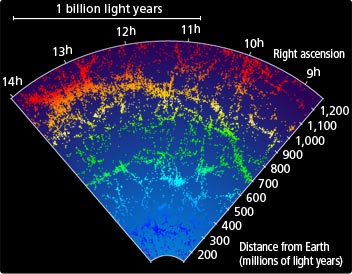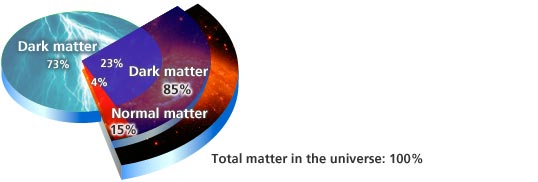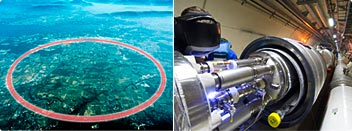The universe comprises innumerable stars and galaxies. The visible matter of which, however, is only a fraction of the whole. It is now known that most of the mass in the universe is made up of “dark matter,” which is invisible and neither emits nor reflects light. The exact nature of this matter has puzzled scientists for nearly 30 years, but an answer may soon emerge.
The Great Wall of China

- The Great Wall of China
- The Great Wall as we see it today was built during the Ming Dynasty.
© PPS
Whether or not the Great Wall of China is visible from the moon has been a matter of great concern for the Chinese.
Listed as a World Heritage Site, the Great Wall of China is one of the greatest known structures in the world. Stretching for thousands of kilometers, it has long been famous as the only manmade object visible from the moon. However, when Yang Liwei, China's first astronaut, traveled into space aboard the craft Shenzhou-5 in 2003, he reported that he could not see the Great Wall. This was big news in China. Although not all Chinese believe such a story, people were reportedly greatly relieved when, in 2004, they heard that Chinese-American astronaut Leroy Chow had brought back digital photos in which the Great Wall could indeed be seen.
There is another super structure in the universe called the “Great Wall,” named after the Great Wall of China. The Great Wall of the cosmos is an unimaginably huge “wall,” or a very large aggregation of galaxies. How did this incredible structure, extending endlessly in the pitch-black universe, come into existence?
The existence of invisible matter
As much as 85% of the matter in the universe is said to be “dark matter” that we have yet to observe. The fact that there must be a lot of invisible matter in the universe was first proved in the early 1970s by Vera Rubin, an American astronomer, while she was observing the Andromeda Galaxy.
Classified as a spiral galaxy, the Andromeda Galaxy is shaped like a flat disk on which stars are clustered together. The stars move focusing around the center of the galaxy, and the number of stars increases the closer to the center one goes. Suppose that visible stars were all the matter that existed in the galaxy, it is conceivable that the closer to the center of the galaxy one went, the stronger the inward force would be on the stars. Therefore, a greater amount of centrifugal force would be necessary to counteract the strong attraction force on the stars, and the speed of those stars during orbit would increase the closer to the center of the galaxy they went.
However, Rubin found that the speed of the stars closer to the center and those further away is approximately the same. The only conceivable explanation for this is that there must be other bodies around the outside of the galaxy where stars seem to be scarce. In other words, dark matter must be present in these areas.
Speed of stars in galaxies
There are many stars in the inner part of galaxies, where there is more attraction force pulling inwards. Conversely, there are fewer stars in the outer part of galaxies, where there is less gravitational attraction. If we assume that attraction and centrifugal force are counterbalanced, then stars closer to the center should be moving faster than the outer ones due to greater centrifugal force. However, both sets of stars are actually moving at about the same speed. This indicates that there must be a huge amount of invisible matter in the outer part of galaxies to account for this paradox.
Dark matter and large-scale cosmic structures
In 1986, a group at the Harvard-Smithsonian Center for Astrophysics studied as many as 1,100 galaxies and found that galaxies form a soap bubble-like distribution in space. Clusters of galaxies are distributed along the surface of these bubbles, which, containing no galaxies, are void. These are called “galaxy bubble structures.” The group also discovered a wall-like structure in which galaxies were densely distributed along the surface of a void. This has been named the “Great Wall”.

Galactic distribution in the universe centered on Earth
This figure shows the galaxy bubble structures. The galaxies are densely distributed from the left to center part shaped like a wall. This is called the Great Wall. Galaxies are color coded according to their distance from Earth.
©Mario Juric and J. Richard Gott, Department of Astrophysical Sciences, Princeton University
How were the Great Wall and bubble structures formed? During the approximately 13.7 billion years since the birth of the universe, dark matter has been indispensable for the formation of the bubble structures. Slight energy fluctuations in the infant universe created gravitational disturbances that brought dark matter together. The dark matter then became the source of gravitational force that pulled normal visible matter into galaxies. In this manner, the distribution of dark matter and galaxies are thought to be nearly identical.
Computer simulations indicate that almost the same bubble structures will form as they are actually observed if there is enough dark matter in the universe. The bubble structures prove the existence of dark matter.
In 2003, WMAP observed cosmic background radiation and revealed what the universe contained. According to the results of WMAP measurements, matter is made up of 15% normal visible matter and 85% unidentified dark matter. These figures also agree with the figures of dark matter derived from the computer simulations shown in Figure 4.

- What the universe contained
- The WMAP observations showed that the universe consists of 73% dark energy, 23% dark matter, and 4% normal matter. The mass in the universe refers to a sum total of visible matter and dark matter, breaking down into 15% normal matter and 85% dark matter.
Computer simulation of bubble structural growth (assuming 30% dark and normal matter and 70% dark energy)
Bright blue dots show a distribution of normal visible matter. In the infant universe, matter was uniformly distributed. Later, the pull of dark matter created super-scale galactic structures.
Simulations were created at the National Center for Supercomputer Applications by Andrey Kravtsov (The University of Chicago) and Anatoly Klypin (New Mexico State University). Visualizations by Andrey Kravtsov.
Identifying dark matter

LHC accelerator at CERN near Geneva
LHC accelerator is about 50m to 150m in the 27-km long underground circular tunnel to accelerate protons.
©CERN
Then what exactly is dark matter? Right now the leading candidate for dark matter is neutralino, an unobserved elemental particle belonging to a family of SUSY (super-symmetry) particles, the existence of which has been deduced by physical theory. Neutralino rarely reacts with normal substances, and therefore has yet to be observed. However, scientists are eager to study dark matter including neutralino and are actively working at the forefront of cosmic-ray physics and the experimental study of elementary particles.
There are two methods for finding dark matter.
The first way to detect dark matter is to capture naturally present dark matter. This involves capturing light emitted from charged particles created by reacting dark matter, which is very rare. Such experiments have been performed deep underground to prevent cosmic rays, which often emit false signals, from interfering with experimental apparatus and producing false results. At present, several such cutting-edge experiments are underway*1 1,000 meters below a mountaintop at Japan's Kamioka Mines in Gifu Prefecture.
- *1Experiments that are underway include XMASS, headed by the Institute for Cosmic Ray Research at the University of Tokyo, and NEWAGE, under the auspices of Kyoto University.
The second way to find dark matter is to create artificial dark matter in massive experimental facilities, such as particle accelerators. Scientists from across the globe are involved in the CERN LCH (Large Hadron Collider) project, with the project's huge accelerator scheduled to be put to practical use in 2007. There are two 27 km-long circular vacuum tunnels built underground on the border between Switzerland and France. Proton particles are accelerated in opposite directions around the tunnels to collide in the detector. If two protons with huge amounts of energy collide, it is thought unseen elementary particles will be observable. Japanese researchers are preparing a number of remarkable experiments*2 to be carried out at the facility.
- *2Dozens of Japanese researchers from institutions such as the International Center for Elementary Particle Physics at the University of Tokyo, the High Energy Accelerator Research Organization, and Kobe University are involved in the Atlas experiment to be conducted at LHC.
The existence of dark matter is no longer a debatable issue. Now all that remains for researchers is to capture dark matter directly. Everything is prepared for such a discovery. The day may be fast approaching when we hear news of firsthand observations of dark matter.
Editorial contributors / Date of article posted
Professor Tomio Kobayashi, International Center for Elementary Particle Physics at the University of Tokyo and Naohiro Takanashi, a doctoral student, Institute of Astronomy at the University of Tokyo / July 2006

